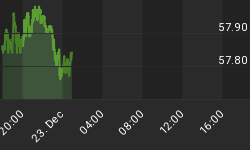The director of research at Google, Ray Kurzweil, wrote a book a number of years ago titled The Singularity. It is a point in the not-too-distant future where the fields of genetics, nanotechnology and robotics will advance to such a level that our own biological limitations will be enhanced beyond recognition. These technologies are accelerating at an exponential rate, where each stage in the progression over a fixed time interval results in a doubling from the previous level. Leaps in technological progress are moving forward not at a linear rate (1-2-3-4-5)but at an exponential one (1-2-4-8-16-32).
In Kurzweil's book, multiple examples of technological innovation are graphed on a logarithmic scale where the percentage change on the vertical axis remains constant over a fixed spacing interval. A classic example of this smooth progression in technological innovation is Moore's Law. The graph below shows the number of transistors squeezed onto an integrated circuit doubling approximately every two years.
This smooth exponential advance in computing power has not only taken place during the past 40 years but also can be extended back to the beginning of the 20th century. From the first electromechanical computer to vacuum tube technology, the exponential advance in computing power marches forward, unbroken by any setbacks, including the occasional war or economic depression.
It is easy for investors to get sucked into the sales pitch coming from one of these high-tech companies that operate in an industry following a smooth exponential progression. Because of their popularity in the financial press, companies in these exponentially advancing industries provide potential investors with a certain familiarity bias that comes from their frequent interviews and press releases. Unfortunately, just because you understand the smooth exponential growth of a new industry doesn't mean the beneficiary will be the tech company you're betting the ranch on. I'm confident the Kurzweil team of futurists can graph the historical progression of these new technologies, showing a doubling every x number of years. Extrapolating this smooth trend line ever higher can bias one's judgment toward a particular company whose future success is far from certain.
Although not as interesting from a storytelling standpoint, a far better strategy for increasing the odds of achieving superior portfolio performance is to set aside the tech "whiz kid" literature and embrace the value investing philosophy. Most of these value stocks will not be featured on TechCrunch or some other blog focusing on bleeding edge companies that run the gamut from biotech to solar power. Replacing exponential growth storytelling with a sound value investing philosophy has historically shown excellent portfolio performance. It is the path most active retail investors should choose when selecting individual securities for a portfolio.
A number of academic studies have shown the merits of investing in stocks that meet certain value investing criteria. In his book, What Works on Wall Street, James O'Shaughnessy reviewed a number of value investing filters, including the ones shown on the graph below. Restricting purchases to the top 50 stocks in the large-cap stock universe that met a particular value investing criterion has produced stellar results relative to an index fund. The workload in producing one of these value portfolios is not that burdensome in that the value screen only needs to be run once a year. The average annual return from purchasing the top 50 stocks that met a particular value investing criterion is graphed below. The results illustrated are from investing in the top 50 value stocks, which can be quite different from investing in a super-sized-value mutual fund.
The value investing results may appear not to be much greater than the average return from investing in the S&P500 index, but over the long haul, a two to three percentage-point increase in the average is significant when factoring in the compounding effects over time. When the overall stock market takes a tumble, will there be losing years after purchasing 50 value stocks? Yes. Will there be years when value stocks lag a broad market index such as the S&P500? Yes. At times, will your patience be tested to the point of abandoning value stocks in order to buy some high-profile tech stock in an industry accelerating ahead at an exponential pace? Yes. In spite of all of these hurdles, your chances of growing your portfolio are vastly improved relative to going "all in" on the latest "moonshot" tech gizmo.
Reading about science and technology is one thing, but investing in these companies is quite another. For individuals who enjoy reading about new technologies (that includes me), it's hard to resist the temptation to join the action in a game of "winner take all" that high-profile entrepreneurs are playing using other people's money. When the financial press focuses so much attention on these creative entrepreneurial founders, resisting the collective pull toward one of their companies is challenging. It's not that anyone shouldn't invest in these exciting exponential growth companies. Private equity run by clever venture capitalists with expertise in these new technologies are the right type of investors for these sorts of new-fangled enterprises.
Focusing on value stocks that aren't the center of the media's attention not only produces stellar returns over the long term but also reduces the chances of joining a graveyard of losers splashed along the "next big thing" pavement. I can't argue with the idea of acquiring a skill set that enables one to find work in an exponential growth industry. After all, those types of jobs usually pay well, and the perks often include free food and laundry service. Participating in one of those exponentially advancing industries is great from a wage income standpoint, but the equity portion of your portfolio is still better off in value stocks. View the value plays in your personal portfolio as a form of insurance, just in case you saddled the wrong tech horse, before Kurzweil's singularity arrives and the robots have eaten your free lunch.


















